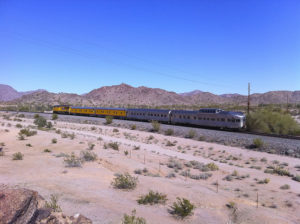On November 5, 2014, a California appellate court reversed a $100.9 million lower court ruling that allowed Union Pacific Railroad Co. (UP) to charge back rent to Santa Fe Pacific Pipelines, Inc. (Santa Fe), a Kinder Morgan Inc. subsidiary that has 1,850 miles of oil pipeline running beneath UP tracks. Problematically, UP’s title to much of its right-of-way was claimed through 19th century land grants from Congress.

Union Pacific company train, courtesy of Clay Gilliland, CC BY-SA 2.0.
The case hinges on the complicated realm of railroad property rights, a matter we’ve discussed before. The trial court had ruled that while the railroad had not provided “direct evidence of its title,” its ownership of the subsurface rights had “been adequately shown for purposes of this proceeding”; thus, it could charge rent for easements beneath the tracks. The railroad obtained a declaration that the rent due as of January 1, 2004 was more than $14 million per year. In April 2012, the trial court issued its decision that the total back rent due was over $81 million, plus prejudgment interest of over $19 million. The back rent accrued because Santa Fe had paid rent during this period based on a previous settlement while waiting for the new rent amount to be determined by the trial court in this litigation.
However, the California Second District Court of Appeal decided that the trial court hadn’t adequately analyzed the railroad’s property rights, considering the large body of relevant state and federal case law. After reviewing laws regarding Congressional land grants to railroads during the mid- to late 1800s, the appellate court ruled that “the railroads had been granted the land for a specific use.” In one example, the Court of Appeal looked at the General Railroad Right-of-Way Act of 1875 and determined that, “the railroad’s rights to the land underneath its rights-of-way granted by the 1875 Act were limited to what was necessary to support the railroad itself.”
UP failed to establish its fee simple ownership or other interest in the property sufficient to entitle it to grant the pipeline easements. However, UP did present evidence during the trial suggesting that it had acquired full title, separate from the Congressional grants, to roughly 50% of the land at issue. Since the trial court had mistakenly concluded that UP had title to “virtually all of the subject property,” it made no finding regarding how much of the land was actually UP’s property. Therefore, the Court of Appeal remanded the case back to the trial court to determine where UP owned the property and could grant the pipeline easements during the period in question.
The Court of Appeal rejected the parties’ remaining contentions, finding that the trial court committed no error in its use of the across-the-fence (ATF) method of valuation, calculations of the rental rate and related factors, and determination of the dates of abandonment of certain easements.
The ruling’s effects—much like the railroads—could stretch across the western half of the country. The decision that Congressional grants of railroad rights-of-way did not give railroads ownership of subsurface rights for purposes unnecessary to support railway use could be applied to other companies that pay rent to railroads to use the ground beneath rail lines. Because the case also touched on abandonment issues, we expect it will also affect future rails-to-trails cases.






Recent Comments